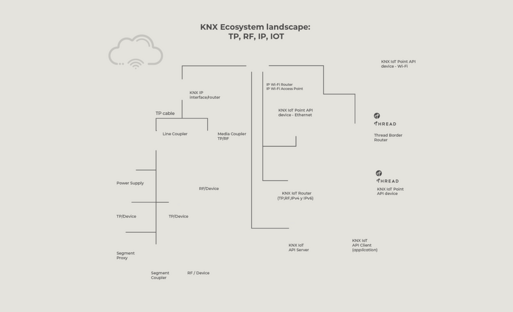Vous voulez une maison ou un bâtiment intelligent
qui a tout pour plaire ? Les appareils et solutions
KNX IoT font évoluer les maisons et bâtiments
intelligents vers un niveau supérieur.
Pourquoi KNX IoT ?
- Interopérabilité et sécurité : KNX est la référence en matière d'interopérabilité. Il suffit de prendre deux appareils certifiés de n'importe quel fournisseur pour qu'ils fonctionnent ensemble au niveau de l'application de manière sécurisée. Suivant cette philosophie, KNX IoT a été conçu pour maintenir le plus haut niveau de sécurité. Les appareils KNX IoT sont dotés d'une sécurité intégrée dès leur conception. Grâce à cette nouvelle technologie KNX IoT robuste, les fabricants et les développeurs peuvent créer les meilleurs appareils, solutions et services qui seront installés par les professionnels de l'industrie des maisons et des bâtiments intelligents.
- Dispositifs KNX IoT natifs (IPv6) : Les dispositifs KNX utilisent désormais une nouvelle approche pour s'intégrer dans l'architecture IPv6. La nouvelle génération d'appareils KNX IoT sera capable de se connecter à des réseaux IP (avec ou sans fil) pour communiquer avec d'autres appareils KNX IoT ainsi qu'avec des appareils KNX classiques qui utilisent la paire torsadée ou la radiofréquence.
- API standardisée : Pour les appareils qui doivent être intégrés dans un réseau KNX, c'est maintenant possible grâce à une API standardisée qui peut se connecter aux installations KNX. Cette API est simple, sécurisée, abstraite des connaissances spécifiques à KNX et à l'épreuve du temps.
- Un seul outil : ETS : Toutes ces possibilités sont rendues possibles grâce à l'utilisation d'ETS. Avec ETS, les appareils KNX de plus de 500 fabricants peuvent être configurés indépendamment de leur couche physique, et les informations relatives au projet peuvent être exportées vers n'importe quel serveur KNX IoT API à l'aide d'un outil indépendant du fournisseur. ETS fournit une interopérabilité de base dans un outil attrayant avec une interface utilisateur moderne.
- KNX, le plus grand écosystème de l'automatisation de la maison et du bâtiment : Avec cette nouvelle possibilité de communiquer en utilisant la technologie KNX, il apporte plus de flexibilité. Les fabricants peuvent désormais utiliser les nouvelles possibilités de développement pour créer des produits et des solutions innovants ; de même, les professionnels ont plus de possibilités de créer un plus grand écosystème KNX dans leurs projets.
Rendre toute maison et tout bâtiment intelligents grâce à KNX IoT
Découvrez pourquoi KNX IoT ouvre un monde de possibilités pour les maisons et bâtiments intelligents dans cette courte vidéo d'introduction.
Vous trouverez des vidéos et des webinaires plus détaillés sur KNX IoT sur notre chaîne YouTube.
KNX, le plus grand paysage de développement de ce type
Une plateforme de développement révolutionnaire servant de base à des solutions remarquables a été présentée au monde en 2023, permettant tous les cas de figure dans les secteurs verticaux de la maison et du bâtiment intelligents. Des produits aux services, tout fabricant ou développeur peut trouver les ressources nécessaires pour créer des solutions uniques.
Découvrez comment fonctionne l'écosystème KNX en survolant les différents éléments de l'image ci-dessous.
KNX IoT Development et KNX Startup Incubator
Intéressé par le développement KNX IoT ? Découvrez plus d'informations sur KNX IoT et comment vous pouvez développer pour KNX IoT, les avantages et le soutien que KNX offre via notre incubateur de startups KNX.
Rejoignez-nous dans notre voyage
Créez un compte MyKNX pour rester informé des dernières nouveautés de KNX IoT, des événements technologiques, des produits KNX innovants et plus encore. Rejoignez notre communauté pour accéder à des informations exclusives et faire partie de l'avenir de l'énergie durable. Inscrivez-vous dès aujourd'hui et restez connecté !





















